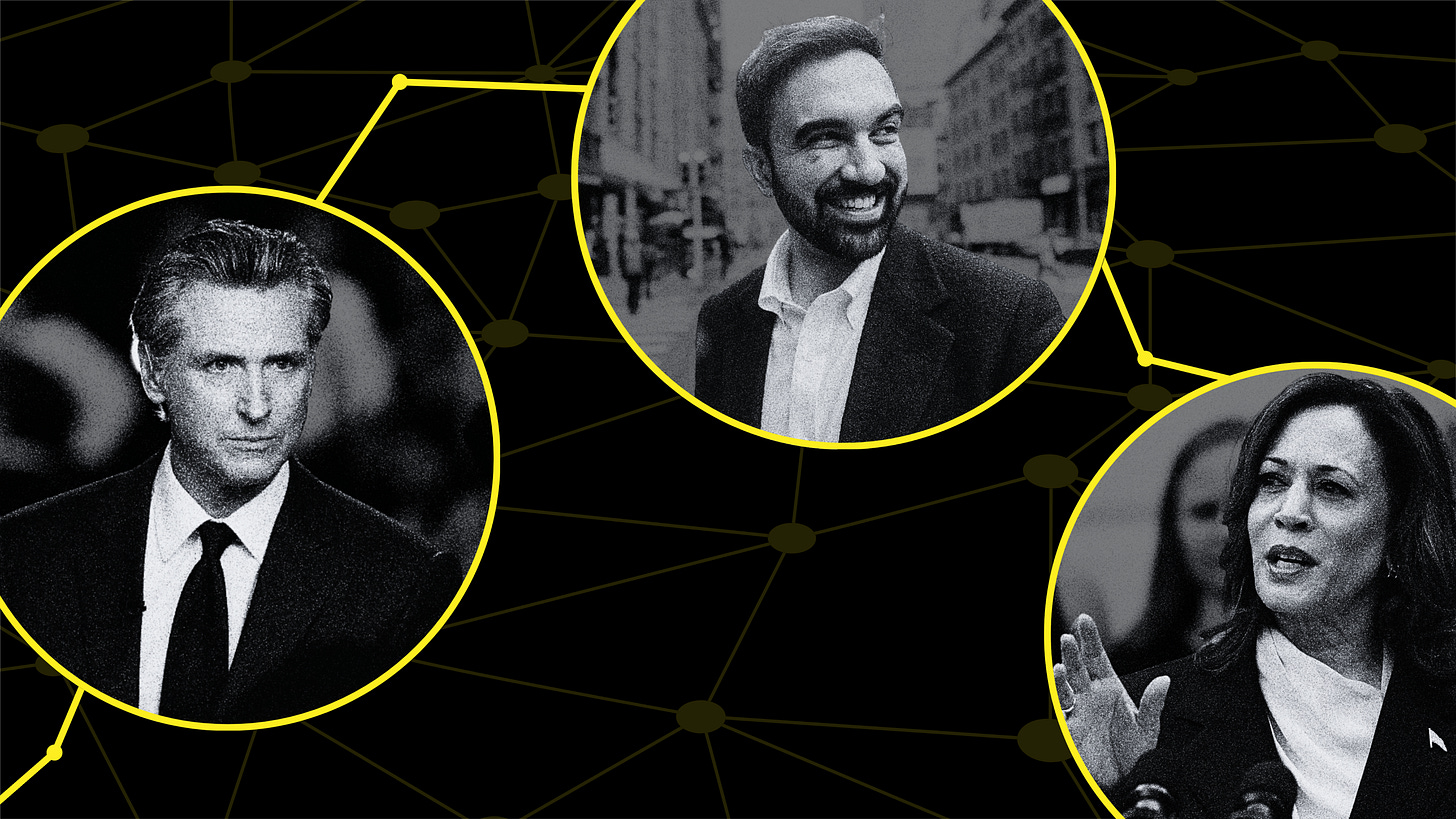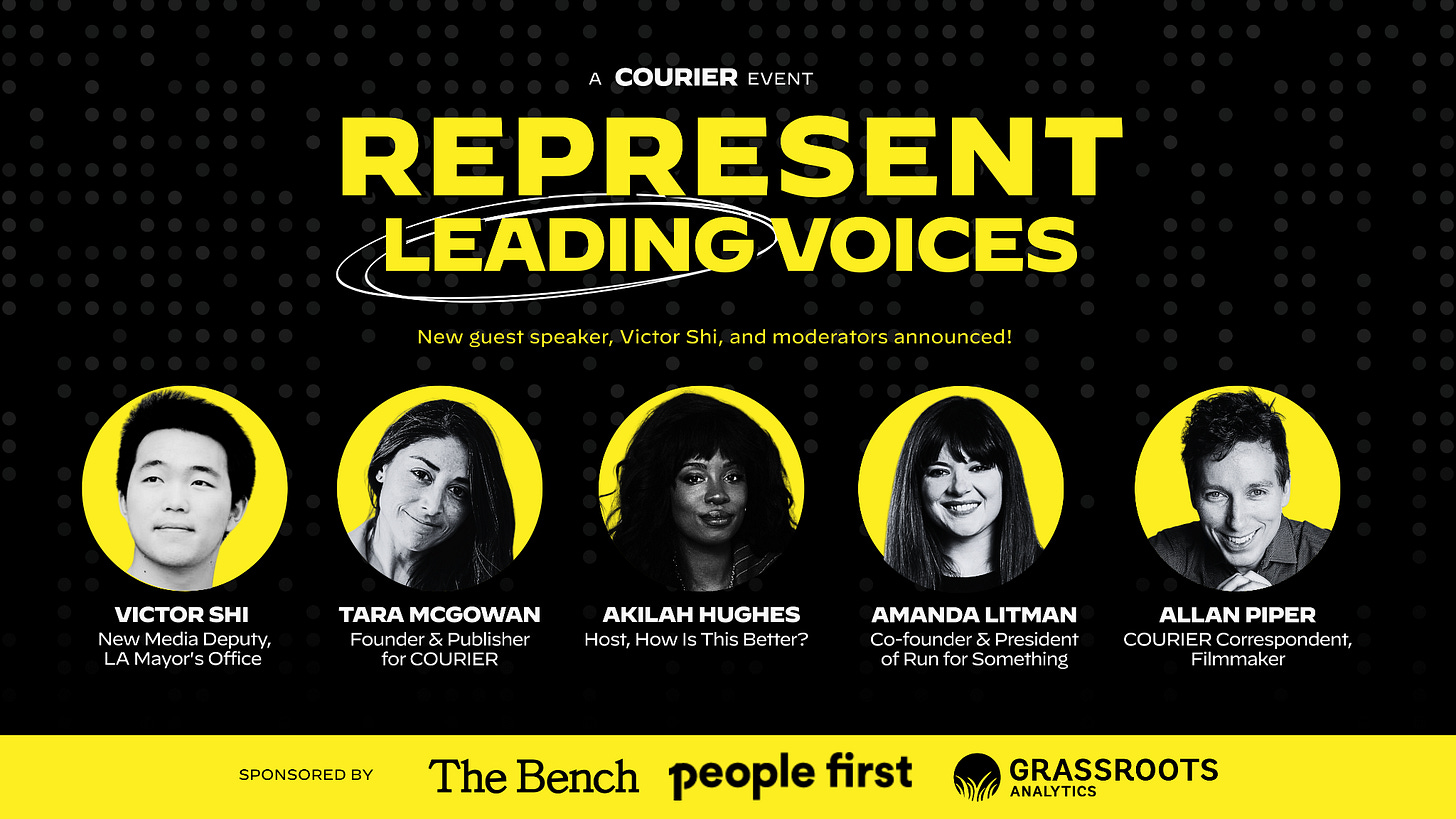One thing Gavin Newsom, Zohran Mamdani, and Kamala Harris have in common
And what other Democrats can learn from their online vitality
Hi everyone – we’re Parker Butler and Lauren Kapp, both long-time FWIW readers, and guest co-authors for today’s edition. We worked on the Harris campaign last year running the Kamala HQ rapid response social media accounts. We have now launched Luminary Strategies, a Gen Z-led digital firm to help Democrats command the internet.
For today’s FWIW, we want to offer our thoughts on the latest waves of social media hype in Democratic politics and what other campaigns and organizations can learn from it.
More below, but first…
Join COURIER in NYC on September 10 for REPRESENT, a live event with the rising class of political leaders and digital creators discussing how to create media-powered movements, how campaigns effectively partner with content creators, and the new digital-first tactics + strategies needed to win.
More New Speakers Announced!
Victor Shi, New Media Deputy, LA Mayor's Office
Tara McGowan, COURIER Founder & Publisher (moderator)
Akilah Hughes, Host, How Is This Better? (moderator)
Amanda Litman, Co-founder & President of Run for Something (moderator)
Allan Piper, COURIER Correspondent, Filmmaker (moderator)
Conversations will be followed by a networking reception, with drinks and light bites provided. Space is extremely limited, so RSVP now to secure your spot at this FREE event and explore VIP options for exclusive Q&A access, reserved seating, and COURIER merch.
There is a longstanding cliché of American politics that dates back decades: “Republicans fall in line. Democrats fall in love.”
When it comes to how each party deploys its online strategies, the adage may be truer than ever.
While armies of MAGA influencers and meme pages pump out a conveyor belt of daily lies and extremism on behalf of their cult leader, Democrats seem to find themselves adrift, latching onto the latest politician with enough of an understanding of the internet to give them a sense of hope in today’s bleak political landscape.
If you’re a Very Online Democrat like we are (and you’re reading this newsletter, you are), you’ve definitely noticed this sort of phenomenon lately. There were the neon green fancams of Brat Summer, the slick cinematic videos of Zohran Mamdani’s mayoral campaign, and now the latest iteration: Gavin Newsom’s relentless use of Trumpisms to mock the authoritarian president.
At first glance, these three social media strategies seem very different. After all, what does a Femininomenon TikTok have to do with an all-caps Trump imitation about Cracker Barrel?
Admittedly, it's true that each strategy we’ve mentioned is designed for different audiences, operating on different timelines, and with different goals.
But it’s this distinction that makes all three digital strategies as notable as they are: None of them are knock-offs of another Democrat.
They each stand out by understanding two key principles: Having authenticity and commanding attention.
In our jobs, we are often asked, “How do we make our boss more like Jeff Jackson or Cory Booker?” We hate to break it to you, but there already is a Jeff Jackson and a Cory Booker. Online audiences are yearning for authenticity — and Democrats can only tap into that by finding a niche that befits their character and personality.
It sounds simple, but it’s the crux of why so many politicians struggle to connect with audiences online.
So, how can Democrats find that niche? Half the battle is investing time into experimentation — and then iterating on what performs best. Whether it's through trends, educational content, or ratio’ing Republicans, what matters most is carving out your own lane.
The next Democrat to post an all-caps rant in the style of Trump’s Truth Social posts isn’t going to see the same magic that Newsom has seen, because that style of mimicry and mockery uniquely fits the brand that the California governor is forging.
The other half of the battle is having a principal who is actually willing to put in the work.
Less than 24 hours after Vice President Kamala Harris moved to the top of the ticket on that fateful day in July, she visited the campaign’s headquarters. Her first stop? The studio. While she took in the “Harris for President” signage for the first time, we recorded her TikTok launch video. Unlike a lot of Democrats, the vice president told us that she understood the importance of showing up for young people online (she does, in fact, love Gen Z).
That kind of buy-in can be rarer than you think. While many Democrats are now talking about the need to invest in digital, putting that into practice is an entirely different story.
There’s another principle that the social strategies of Harris, Mamdani, and Newsom all have in common: They understand the nature of attention.
One of the biggest mistakes that Democrats constantly make is assuming the general population cares what they have to say by default. This may have been the case decades ago, but it couldn’t be less true today.
It doesn’t matter if you’re a backbench member of Congress or a star player — you have to earn attention.
With Kamala HQ, part of the way we did this was through sheer volume. We posted literally hundreds of times per day. The result? Kamala HQ generated more engagements than both the Trump campaign’s “Team Trump” account and Trump’s personal account.
And whether it’s Subway Takes collabs from Mamdani or Bible merch from Newsom, they clearly understand the attention economy too.
For other Democrats who want to get in the game of commanding attention, a good place to start is by piercing through the Democratic Party’s paralyzing culture of risk aversion.
For many Democrats, their content approvals process is where social media posts face death by a thousand cuts. That wasn’t the case for us last year. With a 5-minute approvals process that gave our legal and comms colleagues heartburn, we could respond to and drive the news in real-time.
We don’t know the exact nature of what Mamdani’s and Newsom’s internal content approvals processes look like, but recent remarks from Newsom suggest it’s something quite similar.
Looking ahead, Democrats have to come to terms with the fact that there is no one-size-fits-all when it comes to digital strategy. Every campaign and candidate will have to put in the work and build the internal processes that will allow them to thrive in today’s internet-first environment.
After all, if 91-year-old Republican Senator Chuck Grassley can figure this out, so can we.
Are you a mission-aligned company or organization?
COURIER would love to partner with you and amplify your work to our engaged audience of 190,000+ policy influencers and high-information active news consumers. Send a note to advertising@couriernewsroom.com for more.
That’s it for FWIW this week. This email was sent to 24,527 readers. If you enjoy reading this newsletter each week, would you mind sharing it on X/Twitter, Threads, or Bluesky? Have a tip, idea, or feedback? Reply directly to this email.










Good essay. I am cautious about the over reliance on digital solutions to all things or all problems connected to Democratics. Just wrote about this today. https://ralphrosenberg.substack.com/p/the-promise-and-peril-of-the-dncs The Promise and Peril of the DNC’s New Digital Strategy
You Can’t Software Your Way to Grassroots Power and a Better Brand